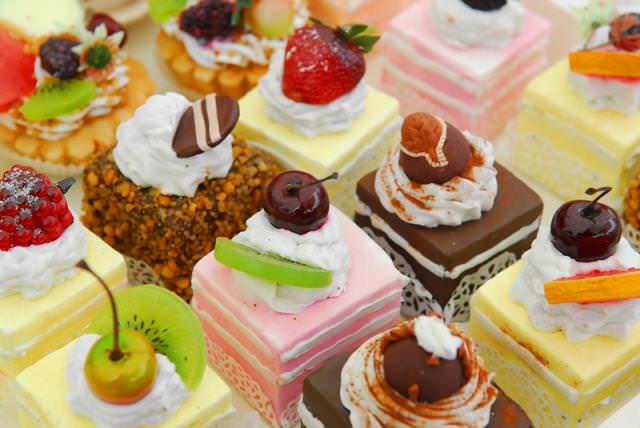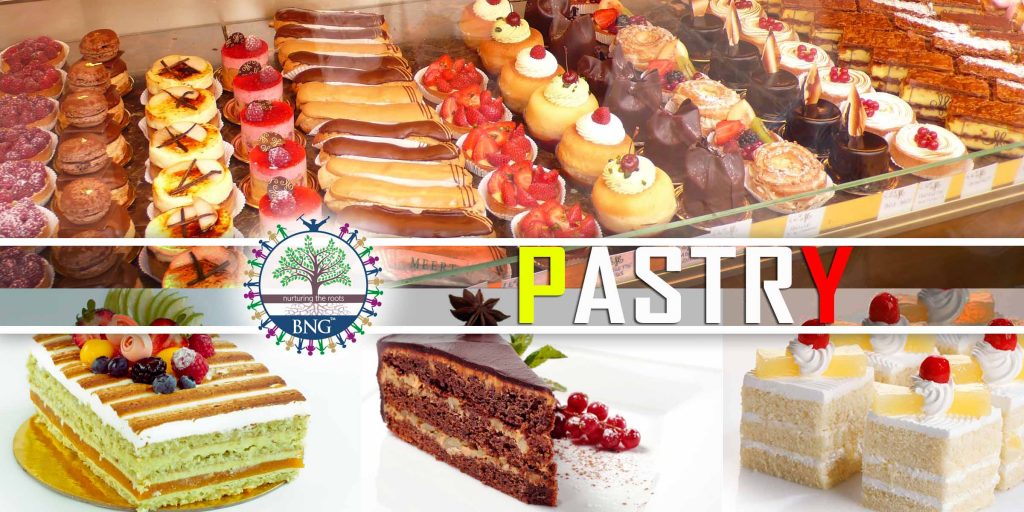Pastry
Most kinds of pastry are made with a combination of flour, fat and a liquid to bind. The texture, flavour and colour of the resulting pastry will vary tremendously depending on the proportions and type of ingredients used.
Main Ingredients of pastry
- Flour

The flour used in pastry making is weak to medium strong. This type of flour requires a longer fermentation period, yet has a better tolerance for extended work on the bench, especially for doughs such as puff or Danish which require multiple rolls and folds.
- Shortening/Fat
Lard was probably the first fat used in pastry making, but has fallen out of favour for health reasons. Pure butter gives pastry a rich flavour and colour and a crisp texture, but it can be difficult to handle. Most bakers use a combination of butter and hard margarine to achieve a balance of good buttery colour and flavour with the short, flaky texture provided by the margarine. Unsalted butter is preferable because it has a lower water content and the amount of salt can be controlled.
- Liquid
Most pastry is bound with water, although milk or other liquids can be used. Fresh milk is acceptable to use in any formula.
- Sugar
It is used to both sweeten the final pastry and create a crisper texture. A teaspoon or two is often added to savoury doughs, because the sugar helps the pastry to colour. The most common sugar used is the white granulated type. This yields the finest product.
- Eggs
They are added for richness in texture and flavour, and because they help bind all the ingredients together. Eggs improve the handling and quality of the dough.
- Yeast
Yeast content is increased in pastry dough because of the high sugar content.
- Spices & Additives
A little grated orange or lemon rind should add just the right flavour to your pastry. Flavouring such as vanilla, almond can be used to enhance the dough, as can spices such as cinnamon, nutmeg, ginger or cardamom.
CLASSIFICATION Of PASTRY
Short Crust > 1. Rub in Method, 2. Creaming Method
Choux Pastry > Hot Water Crust
Puff Pastry > – Flaky, – Rough Puff, – Full Puff, – Danish
Rub-in Method
- Proportion of fat to flour is 1:2.
- Weak flour is used so it absorbs less water.
- Refrigerated fat is rubbed into the flour until it resembles breadcrumbs. This ensures that the fat is evenly dispersed and that all the particles of flour are coated with fat, thus decreasing its ability to absorb water.
- Salt and sugar is dissolved in a little chilled water and is then added to the flour.
- The mixture is kneaded lightly with the fingertips to form a smooth plastic paste.
- All the liquid is added at once to the flour as gradual addition of liquid gives uneven texture and blisters when baked.
- Creaming Method
- Proportion of sugar to fat to flour 1:2:3
- Cream the fat with sugar and add egg to the mixture.
- Flour is then folded in and kneaded lightly to form a soft dough.
Changes in Short-crust while baking
Fat melts. This melted fat turns the dough protein into steam, which gives the leavening action. As the temperature of the dough increases, gluten coagulates and starts to gelatinise. It becomes stiff. Sufficient baking is necessary to drive out moisture in the form of steam. Gluten and starch now absorb the melted fat.
Choux Pastry
- Proportion of fat to flour to water 1:1:2
- Fat and water is boiled together
- Flour is added to the mixture and cooked on low flame
- It is then removed from the flame and eggs are added gradually to the mixture until it reaches dropping consistency.
- It is then piped onto a baking tray and baked immediately.
Changes in Choux Pastry while baking
It leavening agents are air and steam. In the oven, water in the paste is converted into steam. Due to the oven heat, starch on the surface forms a rigid structure that does not allow steam to escape. As more water evaporates, the pressure of steam from inside pushes to the surface and cracks it. These cracks are filled with soft batter from within which in turns forms a film. The process is repeated leading to the formation of a hollow centre. Eventually the egg protein coagulates and starch gets to a rigid form.
Hot water pastry
- Proportion of fat is to water is to flour 1:1:3.
- Heat fat and water together.
- Add this immediately to the flour and knead to a soft dough.
- Eggs may or may not be added
- This pastry is used while it is still warm and pliable.
Puff pastry
Puff pastry dough is referred to as a pastry of a thousand leaves. Its many rich crisp layers are light enough to be airborne. The process of rolling, folding and turning will create hundreds of alternating sheets of fat and dough. The heat of the oven melts the butter and creates steam that puffs the dough into flaky layers. Ingredients used are
- Flour must be from hard wheat bread flour. The amount of rolling which the dough must withstand requires a flour higher in gluten content.
- Shortening is used in relatively small quantities from which the puff is made. The reason for incorporating such a small amount is the great amount of roll-in fat that will be incorporated into the dough. The shortening incorporated into the dough during mixing assists in lubricating the gluten, allowing the gluten in the dough to develop properly.
- Salt is included in some puff pastry doughs for improvement of flavour.
- Roll-in fat is crucial to the quality of the finished puff pastry. It should be of the same consistency as the dough itself. The fats most often used are butter, margarine, shortening, or puff paste [a fat specially blending for puff pastries preparation].
- Leavening Agents are not normally used in this dough. As the dough is folded and rolled with fat, multiple layers of dough sealed around fat are formed. When the dough is placed in the hot oven, the fat begins to melt, enriching and lubricating the dough surrounding it. The fat thereby creates a small pocket in the dough. The moisture released by the fat evaporates as it is heated, creating steam. This steam pushes up the pocket that has been formed. This same action is created in hundreds of pockets within the pastry, creating the volume, a minimum of 8 times its original thickness, and forming the flaky texture that makes this a grand pastry.
Preparation of Puff pastry
- Prepare the base dough with flour, salt, small portion of shortening and liquid.
- Allow to chill for 30 mins. Cream roll-in fat and keep aside.
- Roll out dough into a rectangular shape with ½ “ thickness.
- Divide roll-in fat into three parts and apply one part to the dough, leaving a 1” margin around the edges.
- Fold both ends to the centre and shut like a book fold.
- Repeat this rolling and folding with the other two portions of roll-in fat, chilling in between folding.
- Repeat one more fold without fat.
- Chill and use as required.
Note:
-
Puff pastries: Proportion fat to flour 1:1 Folding three times with fat, once without
-
Flaky pastries: Proportion fat to flour 3:4 Folding once with fat, three times without
-
Rough puff pastries: Proportion fat to flour 3:4 The entire amount of fat is rubbed in with the flour and kneaded to a soft dough. It is then rolled and folded three times without any fat.
-
Danish pastries: Proportion fat to flour 1:2 Folding once with fat
This is a sweet puff pastries made from rich sweet and fermented dough. The dough is partly leavened by fermentation and partly by lamination. The dough is made out of flour, egg, milk, yeast, sugar and 10% fat. The remaining fat is incorporated by the rolled-in method. The dough is not subjected to folding as this rich dough may collapse due to extra manipulation. The dough is baked at a moderately high temperature e.g. Vienna bars, breakfast Danish pastries, croissants etc.
Pastry Faults
A) Short Cut Pastry
- Hard or tough pastries: Too much liquid, less fat, over handling of dough or insufficient rubbing of fat.
- pastries too crumbly: Too much fat, less liquid and/or excess baking powder.
- Shrunk pastries: Excess stretching during rolling and shaping or pastry dough not allowed rest.
- Soggy pastries: Moist or liquidy filling.
B) Choux Pastry
- Pastries does not rise: Oven too cold.
- Sinking of pastries after removing from oven: Excess of eggs or under baking of pastries.
C) Hot Water Pastry
- Cracked pastries: Insufficient liquid; too little kneading of dough; liquid not boiling when flour is being added.
- Dry and difficult to mold pastries: Liquid not boiling when adding flour; too much liquid.
- Hard pastries: Insufficient fat or liquid.
- Heavy pastries: Insufficient baking powder.
- Tough pastries: Over-handling of pastries and/or insufficient fat.
D) Puff Pastry
- Too few layers: Less number of folds; dough not sufficiently chilled while rolling; heaving rolling causing fat to break through and mix with the dough
- Fat running during baking: Fat not chilled after each folding and/or oven too cold.
- Hard or tough pastries: Insufficient liquid used while making dough; too strong a flour used; excess flour used while dusting; dough not covered while resting; cool oven
- Shrunken pastries: Over stretching of pastry while rolling; pastry not rested before baking
- Uneven rise of pastries: Fat unevenly incorporated; uneven rolling.
Find some more about pastry recipes Click Here …
Find all about pastry in wiki click here..





